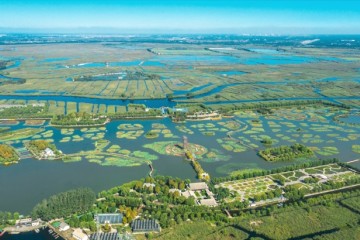
原标题:Museum Day talk about the treasure of the museum
A museum is a history of materialization.On the arrival of World Museum Day, Xinhua News Agency reporters will show you the treasures of cultural relics museums around the country, listen to the wonderful stories behind them, and appreciate the splendid civilization of China like "stars in the sky".In addition to the 10 national treasures reported in the previous and next articles, there are still many relics that can not be displayed one by one.
Tang Dynasty“Tiantuan "——Terracotta figures with camels in three colors of the Tang Dynasty
How did the "pop sky group" come from thousands of years ago? What are they chanting?In the Shaanxi History Museum, as one of the cultural relics forbidden to leave the country, the terracotta figures carried by camels in the Tang Dynasty attract the attention of many tourists.
In 1959, the three colored camel carrying Musical Figurine was unearthed in the tomb of Tang Dynasty in Zhongbao village, the western suburb of Xi'an.It is a tall camel with seven musicians sitting around on its back. In the middle is a plump and graceful woman.Seven men are playing flute, harp, pipa, Sheng, Xiao, pipe and other musical instruments with great interest. Women's red lips are open and their sleeves are elegant
"Since Zhang Qian opened up the Silk Road through the western regions, China's exchanges with Central Asia, Western Asia and Europe have been increasing. This" tour Orchestra "of a thousand years ago is likely to perform the" new voice of Hu Bu "popular in the Tianbao era of Tang Kaiyuan."Jiang Tao, Vice Minister of Exhibition Department of Shaanxi History Museum, said.
"This set of terracotta figures is a masterpiece of ancient Chinese terracotta art, which is composed of two parts: Camel and musical and dancing terracotta figures, and then assembled.It is not only an important material evidence of the development and prosperity of the Tang Dynasty's culture and art and production technology, but also a witness to the exchange and integration of art on the silk road. "
The peak of Chinese landscape painting, the painting of Fuchun Mountain Residence
There is a famous painting of national treasure, which lives on both sides of the Taiwan Strait. The first section is hidden in Hangzhou, and the second section is stored in Taipei. This is the peak of Chinese landscape painting, the painting of Fuchun mountain.
The painting of Fuchun mountain residence was completed by Huang Gongwang, a great painter of Yuan Dynasty, in 1350 or later.In the late Ming Dynasty, it was acquired by Wu Zhiju, a collector of Yixing, and later inherited by Wu Hongyu, his son.In 1650, before his death, Wu Hongyu ordered people to burn paintings and die.Although it was robbed, the last part of it has been burned.
The newly mounted picture of Fuchun Mountain Residence is divided into two parts, which are called the picture of remaining mountain and the useless master volume respectively.The former was popular among the people for a long time, while the latter entered the court during the Qianlong period of the Qing Dynasty.
"In 1938, Mr. Wu Hufan, a famous calligrapher and painter and appraiser, used the bronzes collected by his family to replace the painting of the remaining mountains.In 1956, with the efforts of the famous calligrapher Mr. Sha Menghai and others, Wu Hufan transferred it to Zhejiang Provincial Museum. "Said Lu Jia, director of the calligraphy and Painting Department of zhebo."The painting of the remaining mountains" is named after one mountain, one water and one gully left behind. It is full of the poetic flavor of the hermit wandering in the forest and the spring.
In 2011, the painting of the remaining mountains went to Taiwan and was exhibited in the Palace Museum of Taipei together with the useless teacher scroll, which became a good story of cross-strait cultural exchanges.
"Water control beast "adorable
The treasure of Chengdu Museum is a cute "Zhenshui beast", which is the stone rhinoceros unearthed in Tianfu Square in the center of Chengdu in 2013.
The stone rhinoceros is 3.3m long, 1.2m wide, 1.7m high and weighs about 8.5t. It is carved from the whole red sandstone. It is full-bodied, strong and lovely. It is one of the largest round carving stone carvings unearthed in China at present.
Chengdu Plain, known as "land of abundance", was a place with serious flood before Qin and Han Dynasties.At the end of the Warring States period, Li Bing, the prefecture governor of Qin state, presided over the construction of Dujiangyan, and "made five heads of stone rhinoceros, to hate water essence", then Chengdu became "from drought to flood, from hunger".Archaeologists judged that the stone rhinoceros was probably one of the works made by Li Bing. Therefore, it is truly a thousand year old "Zhenshui beast".
Since its discovery, stone rhinoceros has been loved by the public, who have given it the nickname of "cute ox", "baby" and praised it as "full of vitality and positive energy".
Huang Xiaofeng, a researcher at the Chengdu Museum, said that when the stone rhinoceros was unearthed, its surface was covered with reinforced concrete, weathered and powdered, flaked and peeled off, making people worried.After scientific treatment and protection, the public can see such a healthy and energetic "beast".
Closest "A scholar "Authentic calligraphy works
"Today we have the honor to see Wang Xizhi and thank Empress Wu Zetian."Dong Baohou, director of the academic research department of Liaoning Museum, told reporters.
Long live Tongtian calligraphy collected by Liaoning Provincial Museum is not the real work of Wang Xizhi, but it is called the calligraphy work closest to the real work of "calligrapher".It has always been a royal collection, which was later taken out of the palace by Puyi, and is now stored in Liaoning Provincial Museum.
According to Dong Baohou, at that time, Wu Zetian hoped to get Wang Xizhi's calligraphy works, and found Wang Fangqing, the posterity and Prime Minister of Wang Xizhi.Wang Fangqing dedicated his family's works of Wang Xizhi to Wu Zetian.In the second year of Wansui Tongtian's reign, Wu Zetian ordered the Hongwen school to copy these works.
Dong Baohou said that when Wu Zetian asked the inner government to copy, she must have found the best calligrapher and the best copy. The technique of copying is the highest and the closest to the original.
Unfortunately, the original copy has never been handed down, only the works that were copied at that time have been preserved up to now.
Empress Wu Zetian's extinctive gold slips
Wu Zetian's gold slips, one of the treasures of Henan Museum, is the only existing cultural relic belonging to Wu Zetian. Its discovery is also very dramatic.
1982, Qu xihuai, a farmer in Dengfeng City, Henan Province, picked up a golden rectangle in the crack of Songshan mountain.A cultural relics dealer offered up to 100000 yuan, but he chose to turn over the "treasure" to the state, with a bonus of 1500 yuan.
According to the expert identification, this is Wu Zetian's guilt eliminating gold slips. The purity of gold is over 96%, and 63 words are engraved on the front: "the Lord of the Zhou Dynasty, Wu Zhuo, is fond of music and truth. He is immortal forever. He is dedicated to the Song Mountain gate in the middle of the mountain, and he has made a simple investment in gold. He has begged three officials and nine governments to eliminate the guilt of Wu Zhuo..."That is to say, Wu Zetian sent Taoists to throw briefs to the gods in order to eliminate the crime and eliminate the disaster.
"It used to be an important part of ancient sacrifice and Fengchan activities to bury the slips and policies that engraved the emperor's mind.This is the 'private talker' between the emperor and the emperor, and also the 'top secret' of the country. "Lin Xiaoping, director of the Social Education Department of Henan Museum, said that Wu Zetian's gold slips provided a material basis for understanding the history of Tang Dynasty and Wu Zetian's life.
In 2018, 36 years after the discovery of Empress Wu's golden slips, Qu xihuai, who was seriously ill, had the greatest wish to look at it again and finally achieved what he wanted. The story of an ordinary farmer and a national cultural relic came to a successful end.
[责任编辑: WPY ]
责任编辑:

 和贝亲去沙漠种树,让冰冰霜和梭梭树一起守护夏日清凉
和贝亲去沙漠种树,让冰冰霜和梭梭树一起守护夏日清凉 共筑社会“安全感”|沃尔沃汽车鼎力支持上海市“医苑新星”结业仪式
共筑社会“安全感”|沃尔沃汽车鼎力支持上海市“医苑新星”结业仪式 助力听障高质量就业,无声计划“无声Offer市集”招聘活动真有料
助力听障高质量就业,无声计划“无声Offer市集”招聘活动真有料 美一次丨美的空调联合浙江省日月星辰启动萌愈公益计划,萌愈巴士为自闭
美一次丨美的空调联合浙江省日月星辰启动萌愈公益计划,萌愈巴士为自闭 科技赋能南水北调600亿立方米南水安全北上
科技赋能南水北调600亿立方米南水安全北上 守护一个温暖的春节
守护一个温暖的春节